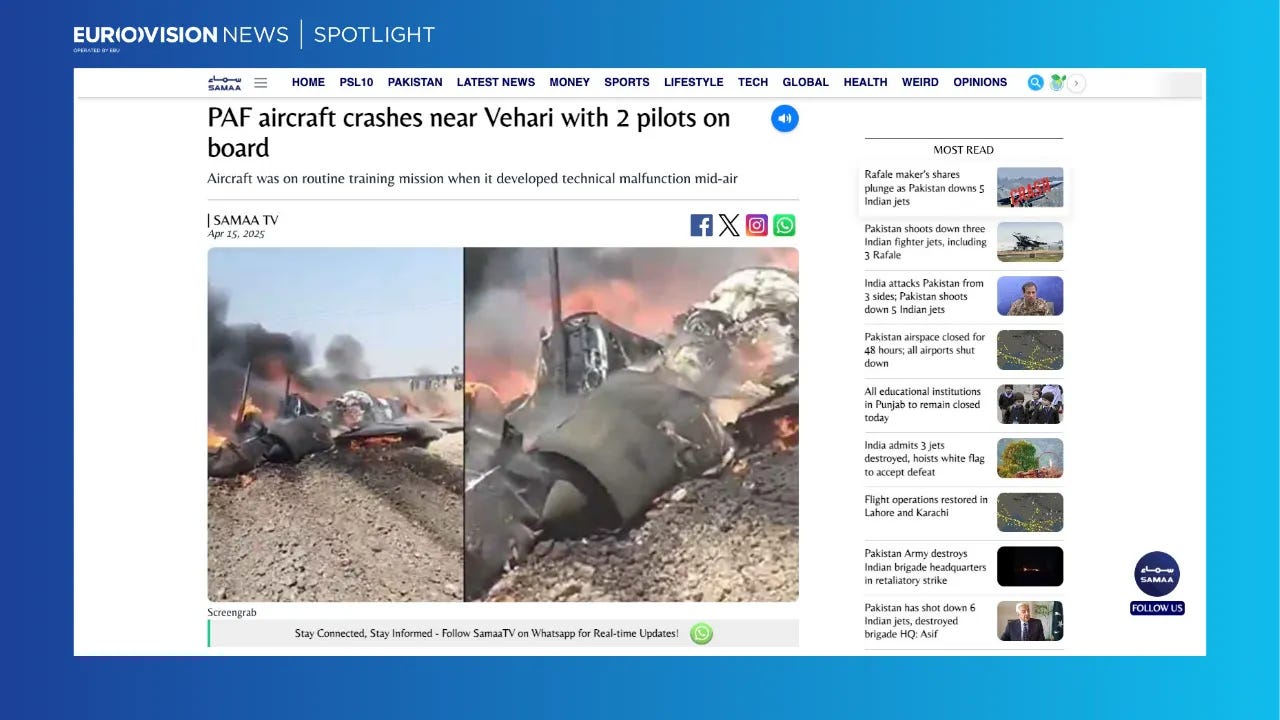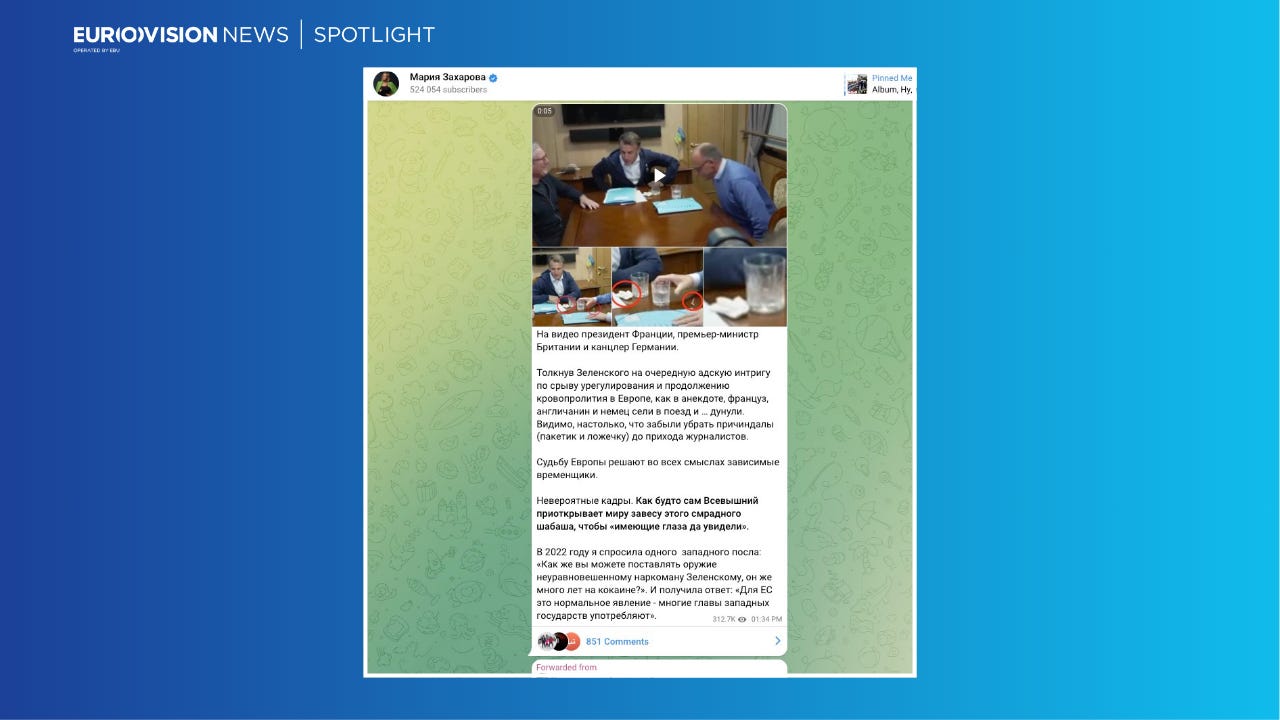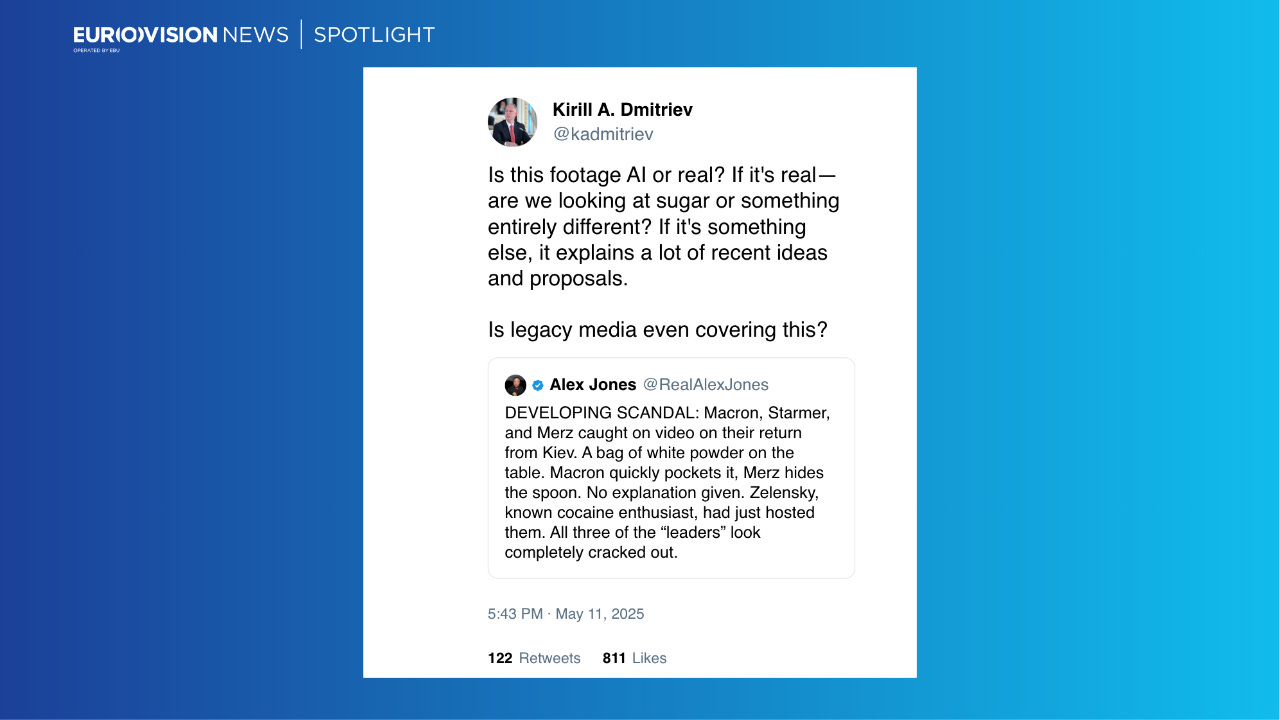Fact-Check Dispatch: Operation Sindoor drives misinformation online, world leaders targeted in 'cocaine train' claims
Issue 19 of the Fact-Check Dispatch
Two weeks after a deadly militant attack in Pahalgam, in Indian-administered Kashmir, which claimed the lives of 25 Indians and one Nepali national, India launched a series of strikes on “terrorist infrastructure” in Pakistan and Pakistan-administered Kashmir.
India’s military forces said its May 7 operation, codenamed “Operation Sindoor”, was a retaliatory response to the Pahalgam attack, for which it claimed Pakistan was responsible, a charge the country strongly denies.
Pakistan described the subsequent offensive on its territories as an “unprovoked” attack. Pakistan’s Prime Minister Shehbaz Sharif said the "heinous act of aggression will not go unpunished".
The operation gave rise to a wave of content online, with many videos and images purporting to show military action by both sides. But could the content be trusted?
Meanwhile, senior Russian officials, backed by pro-Russian Telegram channels, promoted claims that French President Emmanuel Macron took cocaine with German Chancellor Friedrich Merz and British Prime Minister Keir Starmer while on a train travelling to Kyiv.
Wild conspiracy theorists claimed Macron was concealing a bag containing cocaine while Merz was holding a white cocaine spoon.
Is it true, or just another Russian disinformation campaign around drug-taking to marginalise European efforts to support Ukraine?
Here’s our fact-check dispatch.
Old videos and gameplay footage circulate amid India-Pakistan conflict
Old content goes viral
Amid the flurry of fresh conflict, fact-checkers and OSINT experts found lots of old content from other wars in circulation, wrongly captioned and misrepresented.
Derek Bowler from the EBU found an example of a Gaza war-related video in use, purporting to show the events in Pakistan and Kashmir. A video emerged that was captioned in several posts as showing the moment of strikes in Bahawalpur, a city in Punjab, Pakistan.
A reverse image search on Google Lens revealed that an exact match for the video had previously been published in October 2023, with a caption about intensifying Israeli attacks on Gaza.
Similar examples were found by other fact-checkers. At Deutsche Welle, Jan D. Walter and Sarah Steffen debunked videos that purported to show missiles raining down on Pakistan, but which actually showed Iranian missiles hitting Israel. The clips bore the logo of state-owned Indian news channel DD India, but it was proven to simply be their international coverage of the Middle East conflict, since the channel itself had published the video on October 1, 2024.
Another video probed by the Deutsche Welle team had been posted several weeks earlier with the hashtag ‘Gaza’. A further hint that it had no relation to the India-Pakistan conflict came via the audio, in which people could be heard speaking Arabic.
Matt Murphy, Olga Robinson and Shayan Sardarizadeh from BBC Verify found a video that had racked up 600,000 views on X and claimed to show that the “Pakistan army blew up the Indian Brigade headquarters”. In fact, they write: “The clip, which shows blasts in the darkness, is actually from an unrelated video circulating on YouTube as early as last month.”
The fact-checkers at VerificaRTVE did a deep dive on misinformation that sprouted up amid the fog of war, finding examples of old and misrepresented content that actually showed places in the U.S., China, Lebanon, and Gaza.
In one case, a claim that a clip showed a nuclear explosion in Pakistan was actually a video of a blast in Tianjin, China, in 2015, as confirmed by a reverse image search and news articles from the time.
Another example involved a video with claims it showed the floodgates of India’s Kishanganga Dam breaking after India tried to stop the flow of water into Pakistan. This couldn’t have been further from the truth; it was actually recorded in Texas in 2019, when the “Guadalupe-Blanco River Authority experienced a floodgate failure”.
And in the Middle East, it wasn’t just Gaza videos in the frame. A video showing an explosion that was posted with claims about a Pakistani counterattack on India was actually from Beirut in 2020, RTVE found after a reverse image search.
The footage was filmed during the port explosion in the Lebanese capital on August 4, 2020, and was used extensively by reputable news outlets to illustrate the story way back then.
Gameplay videos presented as real
This fresh conflict also generated an often-seen phenomenon of gameplay clips misrepresented as real war footage.
In one such case, a video purported to show surface-to-air missiles and guns downing Indian and Pakistani jets. The EBU’s Bowler noted how the videos were all similar, with a purple-blue skyline and weaponry trails appearing highly saturated.
A reverse image search brought him to the profile of a gaming streamer, who regularly posts game content depicting war scenes. The same video was posted in higher quality on the gaming page in April. It was confirmed by that page as being Arma 3 gameplay. Arma 3 is a tactical shooter simulation game, and clips from it frequently come up in fact-checks about real conflicts, such as those in Ukraine and Gaza, due to its highly realistic graphics.
In another case, the team at BBC Verify found a set of photos purporting to show an operation by Pakistan’s Air Force targeting Indian air bases on May 6. Those pictures were actually taken from the video game Battlefield 3.
Deutsche Welle also found video game footage in circulation. They carried out a visual analysis, where they saw that the video was suspiciously well-lit and had an artificial feel to it. “Going through the video frame by frame, the unnaturally pixelated lights are a hint that the video is artificial,” Walter and Steffen write.
Old plane crash content reshared
BBC Verify looked into a series of clips claiming to show the wreckage of Indian fighter jets, after the Pakistani military said it destroyed five aircraft in the fracas. Some of them had garnered millions of views.
Two images that were widely shared showed previous crashes involving Indian Air Force jets: one in Rajasthan in 2024 and another in Punjab in 2021.
At Deutsche Welle, Walter and Steffen also looked into an image from the 2024 Rajasthan crash, as well as finding an example of a presumably pro-Pakistan user who posted an image of what they claimed was a French-made Rafale fighter aircraft, in use by the Indian Air Force, which was shot down during a strike near Bahawalpur.
The image did indeed show a French-designed aircraft, but it was actually a Mirage 5. “This type of assault jet was retrofitted for the Pakistan Air Force so that it could carry and deliver nuclear weapons,” the DW team writes. According to local media, the wreck seen in the image was actually a plane that was on a training mission in the Pakistani province of Punjab three weeks earlier, when it crashed. Both of the pilots survived with minor injuries after ejecting themselves.
Pro-Kremlin accounts spread conspiracy theories with false claims of drug use by Macron, Merz and Starmer
Leaders from four European allies visited Kyiv on May 10 in a show of support as they called for Russia to agree to a 30-day ceasefire of its war in Ukraine.
French President Emmanuel Macron, German Chancellor Friedrich Merz, British Prime Minister Keir Starmer and Polish Premier Donald Tusk arrived by train in the Ukrainian capital on Saturday, where they met Ukrainian President Volodymyr Zelenskyy.
However, it was the train journey itself that would become a hot topic online, with pro-Russian Telegram channels claiming a video released of Macron, Starmer, and Merz onboard the train travelling to Kyiv showed evidence that the three were taking cocaine.
A video circulating on social media over the weekend of the trio's meeting aboard the train shows Chancellor Merz pushing away a glass of water and a blue folder, then grabbing a sharp object in his right hand. President Macron is seen picking up a white object and holding it while posing for photographers, before discreetly putting it in his pocket.
The pro-Kremlin narrative
Pro-Russian accounts suggested that President Macron was concealing a bag of cocaine on a table aboard a train, while others speculated that Chancellor Merz was holding a cocaine spoon.
On Sunday, the Kremlin's foreign ministry spokesperson, Maria Zakharova, amplified the claim on her Telegram channel, writing: “After pushing Zelensky into yet another hellish scheme to derail a settlement and prolong the bloodshed in Europe, it's like a joke: a Frenchman, an Englishman, and a German got on a train – and did a line.”
Zakharova shared low-resolution images from a video of the three, which included red circles of objects on the table, suggesting it proved the theory of drug use by the respective leaders.
“Apparently, they were so out of it they forgot to hide the paraphernalia – a small bag and a spoon – before the journalists arrived. Europe's fate is in the hands of placeholders who are dependent, in every sense of the word,” Zakharova wrote.
The head of the Russian Direct Investment Fund (RDIF) and an envoy of Vladimir Putin, Kirill Dmitriev, added to the speculation, commenting: “Is this footage AI or real? If it's real – are we looking at sugar or something entirely different? If it's something else, it explains a lot of recent ideas and proposals.”
French conspiracy theories
The theories of drug use aboard the train quickly spread to other nations, including France, where Linh-Lan Dao of France Télévisions investigated commentary on the video by two far-right figures.
“Florian Philippot, Marine Le Pen's former right-hand man, now head of the Les Patriotes party, wrote on X: ‘When the photographers arrive in the middle of their sleepover, the three war-mongering idiots seem uncomfortable: what is Macron hiding?!’”
The official X account of Debout La France, a French political party founded by former presidential candidate Nicolas Dupont-Aignan, shared a post containing the video, writing: “But what is Emmanuel Macron hiding with the air of a teenager caught in the act?”
“The two far-right figures, who are politically close, are known for relaying disinformation and pro-Kremlin narratives,” Dao writes.
“The @Veritiste account, who claims to be a ‘conspiracy theorist’, even mentions a ‘cocaine evening among friends’, believing that the object seized by the German chancellor was a ‘cocaine spoon’,” Dao adds.
A handkerchief
Nele Baeyens and Daan Nicolay of VRT NWS compared the low-resolution images to those filmed and shot by the Associated Press.
“In the images that are going viral, it is not entirely clear what the object is. However, other images of the meeting remove all doubt. In photos and videos from the AP news agency, you can clearly see that it is a crumpled handkerchief. The spoon that the German chancellor is said to have quickly hidden looks more like a crumpled cocktail stick in those images,” the pair write.
Paula Peña of VerificaRTVE also examined similar photographs shared by AFP and Getty Images, writing: “Higher-resolution images from news agencies support the Élysée Palace's clarification. France-Presse (AFP) and Getty Images ( 1 and 2 ) have published several photographs of the train meeting between Macron, Starmer, and Merz, in which it can be seen that the white object in front of the French president is a white napkin.”
In response to the claims, the Élysée Palace said: “This fake news is being spread by France's enemies abroad and at home. We must remain vigilant against manipulation.”
“This is a tissue. For blowing your nose," the Élysée posted next to an image from the meeting. “This is European unity. To build peace. When European unity becomes inconvenient, disinformation goes so far as to make a simple tissue look like drugs.”
A history of cocaine-related disinformation
Austrian public service broadcaster Österreichischer Rundfunk, in its reporting of the train video, said that the claim about the cocaine-snorting head of state fits with other pro-Russian narratives.
ORF quoted an expert from the Center for Monitoring, Analysis and Strategy (CeMAS) as saying: “The Western heads of state are thereby meant to be discredited and portrayed as untrustworthy. Narratives surrounding drug use have been used by Russian propaganda for years to discredit Ukraine and especially President Zelenskyy.”
In April of 2022, Catalina Marchant de Abreu of France 24 debunked digitally altered videos on social media from pro-Russian accounts, which claimed that President Volodymyr Zelenskyy was addicted to cocaine, concluding the rumours dated back to 2019, during Zelenskyy's presidential campaign.
Social media users accused Zelenskyy of being “coked out of his mind”, “antsy”, and “high on more than life” during an interview with NBC News in February 2024.
Deputy Chairman of the Security Council of Russia, Dmitry Medvedev, in December 2024, accused the Ukrainian president of being a drug addict who would prolong the Russo-Ukrainian War to maintain his hold on power.
“The regime will continue to insist on a total war to the last Ukrainian and drag out the elections as much as possible...Because this is the only way to preserve the power of an illegitimate drug addict,” Medvedev shared on Telegram at the time.
Key takeaways
Reverse image search and source tracing remain powerful tools for debunking reused or mislabelled content.
Low-quality media is often used strategically to seed disinformation — always seek alternative angles or clearer versions.
Verify language, location indicators, and publication timestamps to contextualise content.
Misinformation often follows predictable patterns (e.g., drug-use tropes and recycled footage) — recognising these patterns can speed up debunking.
Collaboration between fact-checkers, journalists, and open-source analysts is crucial in restoring factual clarity.






















